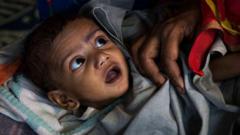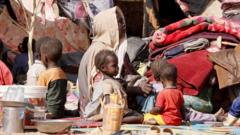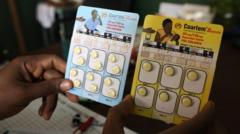While India has significantly high rates of child stunting, with over a third of its under-five children affected, research emphasizes that caste discrimination plays a significant role in these nutrition disparities, overshadowing traditional height-gap debates.
Examining Caste Disparities: India’s Child Stunting Crisis Unveiled

Examining Caste Disparities: India’s Child Stunting Crisis Unveiled
A recent study highlights the role of caste in child malnutrition, revealing India’s stunting rates exceed those in Sub-Saharan Africa.
India’s child stunting crisis has reached alarming heights, with over 35% of the country’s 137 million children under five reportedly stunted. Recent research by Ashwini Deshpande of Ashoka University and Rajesh Ramachandran from Monash University, Malaysia, attributes a significant part of this crisis to enduring caste discrimination.
Globally, India and Sub-Saharan Africa account for 44% of the under-five population but shockingly represent about 70% of stunted children, a critical indicator of malnutrition. Current estimations suggest that while Sub-Saharan Africa's average stunting rate is 33.6%, India stands even higher at 35.7%.
A child is considered stunted if they are shorter than the expected height for their age, which reflects serious nutritional deficiencies. Notably, Deshpande and Ramachandran's study suggests that focusing primarily on the physical height gap between Indian and Sub-Saharan African children overlooks the complexities of social identity, particularly caste dynamics, which greatly influence child nutrition in India.
The first 1,000 days of a child's life, often termed the "golden period", are crucially important, as 80% of brain development occurs by age two. This foundational stage is significantly impacted by factors like healthcare access, nutrition, early learning, and overall safety, all determinants of a child’s future.
With both regions experiencing rapid middle-class growth and young populations, the barriers of poverty and development are similar. As per the World Bank, more than 85% of the global poor reside in both Sub-Saharan Africa and South Asia, including India.
The study emphasizes that among socially disadvantaged groups in India, such as adivasis and Dalits, the stunting rate is alarmingly higher. Notably, children from non-stigmatized, higher-ranked caste groups experience much lower stunting rates compared to those from marginalized communities, indicating that social stratification plays a vital role in nutritional access.
Despite India's sustained efforts for the past seven decades through affirmative actions, caste hierarchies still remain prevalent, leading to disparities in nutritional intake and living conditions. The authors assert that children from affluent backgrounds enjoy more calorie access and a healthier living environment compared to their less fortunate peers.
Scholars have engaged in heated debates regarding the causes of these stunting rates, with some attributing the differences to possible genetic factors while others argue that historical nutritional improvements have progressively narrowed the gap. External factors also show mixed outcomes across genders, complicating this discourse.
While it’s a known fact that stunting has decreased throughout various social groups in India, the burden disproportionately affects families that are economically disadvantaged or possess lower maternal education levels. A recent study corroborated that interventions focusing on health and nourishment have positively contributed to stunting reduction in certain states.
Conclusively, the intricate relationship of caste and child malnutrition sheds light on an often-overlooked aspect of this public health crisis. This study utilizes extensive demographic and health surveys, combining data from India (2019-21) and Sub-Saharan Africa (from 19 countries since 2015), covering over 195,000 children under five in India and about 200,000 in Sub-Saharan Africa, to present a compelling argument that social identity must be at the forefront of discussions surrounding child nutrition.



















